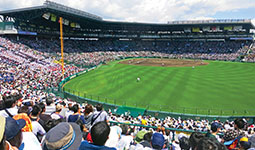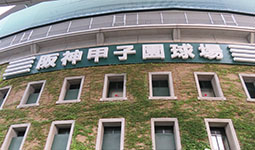Home > Highlighting JAPAN > Highlighting Japan June 2018 > Regional Revitalization through Sports
Highlighting JAPAN


KOSHIEN
Japan’s Field of Dreams
Baseball is truly Japan’s national pastime, and many pro players first gained national prominence at Koshien, high school baseball’s premier tournament.
HANSHIN Koshien Stadium was built in 1924 to host the National Middle School Baseball Championship, which after Japan’s 1948 education system reform switched to the high school level. The tournament’s popularity soared, and since 1953 NHK (Japan Broadcasting Corporation) has shown every inning of more than eighty games in spring and summer. Although the stadium is actually the home field of the Hanshin Tigers professional team, the team gladly turns it over to high school ballplayers for about a month every year.
When the tournament began in 1915, it was played in a stadium that seated five thousand people. So many fans wanted to watch the games live that Koshien was built to accommodate them. Finished in 1924, the current stadium is ten times bigger and has a capacity of over fifty thousand. Initially there were fears that it would never fill up, but by the third day of the tournament the stands were overflowing.
Why is watching high school students play baseball at Koshien so riveting for so many?
Masahiko Takenaka, the secretary of the Japan High School Baseball Federation, explains it this way. “Before and after the games, both teams bow to each other, something that appeals to the Japanese preference for respect and harmony in team sports. In addition, the desire to support your hometown, alma mater or schools you have a connection with is born out of strong Japanese regionalism. Then there are the buses that come from all over the country, carrying the players’ families, teachers, other students and alumni here to support the teams, which is a moving sight. These elements have become part of Koshien’s history and helped secure its place in the Japanese consciousness as a sacred place.”
Japanese fans are particularly passionate about the summer classic. “A big factor is that the summer tournament features one representative school from each prefecture playing in a one-shot tournament,” Takenaka notes. “The third-year students take their last stand before leaving the team for graduation, and they play with their backs to the wall and put their souls into every play. This gives rise to unpredictable drama, such as when an underdog public school defeats an elite private one.
“Incidentally,” he adds, “many of the stars of Japan’s professional baseball league and the U.S. Major Leagues played at Koshien, and it was the first time many of them drew national attention. This is another reason for the tournament’s popularity.”
Japan’s plummeting birthrate and the growing prominence of other sports, however, have created a strong sense of unease.
“One of our awareness projects under the ‘200-Year Plan of High School Baseball’ involves cooperating with the coaches and players from each school that participated in both past and present spring and summer tournaments. We started an event this year to give young elementary school students a chance to experience baseball,” Takenaka says. “We hope the seeds we are planting now will someday bear fruit.”
“Koshien” is not just the nickname of the national high school baseball tournament. Various other high school tournaments and events now incorporate the name, acknowledging its power, giving rise to the anime Koshien, sweets Koshien, dance Koshien, theater Koshien, and so on.
The 2018 summer tournament will be the centennial competition, and fifty-six schools from around the country—the largest number in history—will come to engage in fierce battle. No doubt the emotional voltage of the archipelago will rise higher than it ever has before.
© 2009 Cabinet Office, Government of Japan








